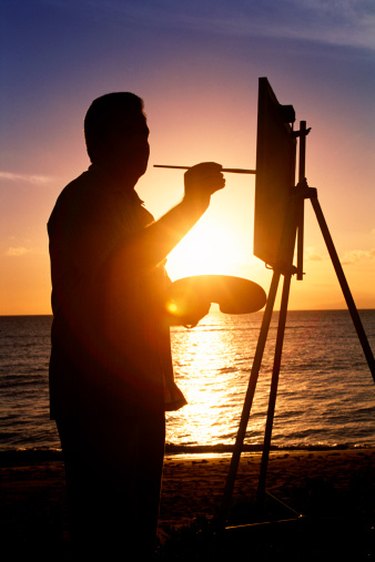Things You'll Need
Cadmium Red Light
Cadmium Orange Medium
Cadmium Yellow Light
Dioxazine purple
Ultramarine Blue
Titanium White
1-inch, synthetic fiber brush
Flats, filberts and rounds of various sizes
Pressed illustration board, cold or hot
Palette with dividers

Acrylic paints are made from polymer plastic. They dry fast and are more difficult to blend on the canvas than oils, but it is this quality which allows for many layers of pigment in a small amount of time. You can achieve a great amount of depth with acrylic-based paints by "washing" layers of pigment over the white of the canvas to create luminous, glowing sunsets.
Planning Your Sunset
Step 1
Work from photographs. Study the shape of the clouds in your sunset. Study the bands of color and light. Note where the colors are bright and warm and where they are cool and receding.
Video of the Day
Step 2
Lightly sketch the shapes of your skyline on a piece of illustration board, watercolor paper, or canvas primed with gesso that has been sanded until smooth. Plan where the bands of color meet, blend and fade. Outline clouds and prepare to keep them white during the first layer of paint.
Step 3
Note in your photograph where the sunset is glowing brightest. Carefully outline the shape of the glow in your composition. Note also the brightest places on your clouds. Carefully outline the glow around the clouds.
Warm and Cool Washes
Step 1
In six sections of your divided palette, place a dab of each of the colors for your sunset.
Step 2
Add water to each color, until you have a liquid that can soak your 1-inch brush.
Step 3
With your 1-inch brush, apply light-tinted, liquid washes to the areas designated for color on your composition. Keep the warm colors together, yellows closest to the sun, overlapping with orange and red. Keep the cool colors together, letting ultramarine blue and red overlap slightly. Blue bleeds into dioxaxine purple to create darker areas of the sky, farthest from the sunset. Avoid areas designated for clouds and the "glowing" area of your sunset.
Painting Clouds
Step 1
Clouds against a bright sunset are darker because they are blocking light. Paint clouds closest to the sun in purples and blues. Use round brushes to apply opaque pigment to the composition for your clouds
Step 2
Clouds farther from the sunset will be lighter blue, or even white, with reflections of yellow, orange and pink where they face the sunset. Mix ultramarine with white to get tints of blue for your lighter clouds, and leave some of the edges white for the glow.
Step 3
Once you have your clouds laid in, make shades of pink, orange and yellow by mixing each color with white. Apply where you have designated each color on your clouds and apply thick, opaque layers of yellow tint to the brightest area glowing around your sun.
Tip
For a more "golden" sunset, use yellow ocher instead of cadmium orange. You can also use umber or sienna to get dusky, dark clouds.
Warning
Wait for your layers to dry before applying the next layer. You can use a hairdryer on the coolest setting to speed up the drying time.
Video of the Day